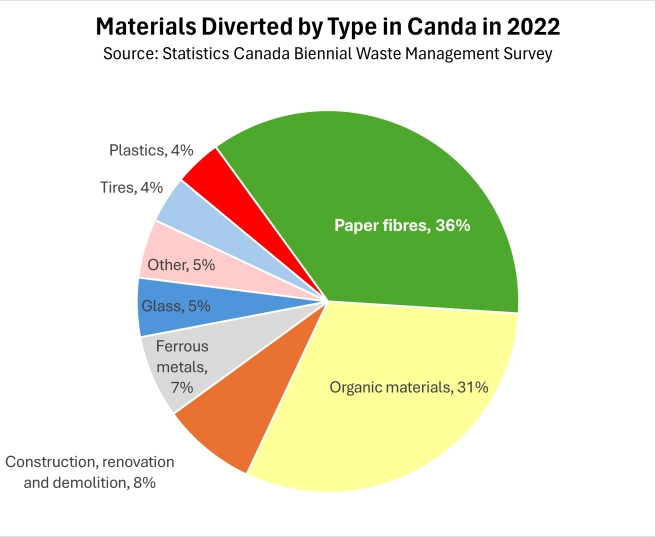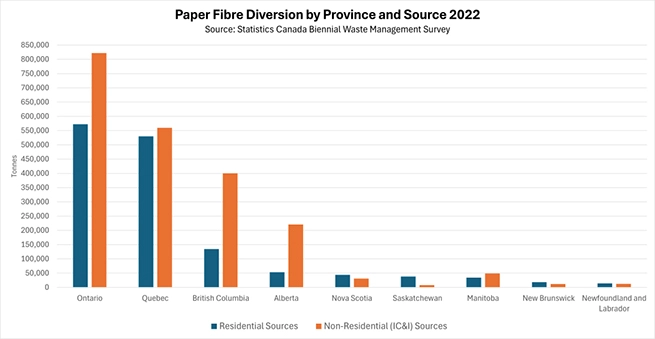Statistics Canada released the results of its biennial Waste Management Survey1, containing waste diversion data for 2022.
PPEC’s latest blog breaks down the stats and discusses the importance of recycling data.
The new data shows that Canadian households and businesses diverted 9,898,882 tonnes of waste in 2022, and of the total amount diverted, 3,571,384 tonnes were paper fibres, which includes newsprint, cardboard and boxboard, and mixed paper.
Paper fibres represent the majority of materials diverted, with 36% of total waste diverted from Canadian landfills in 2022.

The next largest category of diverted materials, at 31%, are organic materials, which includes food waste, yard waste, and other organics such as wood and agricultural materials. The 2022 survey represents the first time Canada’s statistics agency has published a breakdown of composted organic material by category, with the majority or organic material, 52% or 1.6 million tonnes, being reported as food waste.
Digging deeper into the paper data, of the 3.57 million total tonnes of fibre diverted in Canada in 2022, 40% was diverted through residential sources (ie. Blue Box-type residential packaging recycling programs), while the remaining 60% was diverted through non-residential sources (ie. Industrial Commercial and Institutional (IC&I) sector).
Below is a full breakdown of paper fibre diversion by province and source, with the two most populous provinces – Ontario and Quebec which together represent over 60% of Canada’s total population – diverting the most paper fibre from both residential and IC&I sources, at 70% of the total tonnes diverted (2,484,179 / 3,571,384).

On the new 2022 data, Statistics Canada reported that “diverting plastic waste to avoid disposal has become a challenge because of the many different types of hard-to-recycle plastics being produced for consumption and entering the waste stream.”
Of the nearly 9.9 million total tonnes of materials diverted, 366,694 tonnes included plastic materials which were sent to material recycling facilities (where recyclables are brought to be sorted and prepared for sale), representing 3.7 per cent of total diversion, with most of the plastic (72%) coming from residential sources.
The Government of Canada has been working to address plastic as part of its Zero Plastic Waste Agenda, and with its Single-use Plastics Prohibitions Regulations, which came into effect December 2022, and most recently announced its new Federal Plastics Registry, which will track plastic from production to end of life. The federal government is also considering other regulatory proposals for plastics such as minimum recycled content requirements and federal labelling rules for recyclability and compostability.
And Canada is also currently at the table along with other governments, businesses, and stakeholders from around the world meeting in Ottawa for the fourth session of the Intergovernmental Negotiating Committee on Plastic Pollution (INC-4), taking place from April 23 to 29, to work on developing an international legally binding instrument to end plastic pollution.
Reducing plastic waste, and in general, diverting as much waste as possible, is not only an environmental imperative, but it also makes business sense.
A circular economy approach to managing paper packaging is baked right into our industry’s business model – it makes sense to collect as much used paper fibres as possible to use as their feedstock, instead of using virgin materials.
Given the importance of recycling to PPEC and its members, who rely on using recycled fibres in their operations, PPEC monitors available recycling data in the residential and IC&I waste streams. It’s important to have accurate data to be able to track and measure progress, and to make evidenced-based policy and regulatory decisions.
And from the available data, including these latest stats, it’s clear that paper packaging is a highly diverted and recycled material in Canada.
Canada’s paper packaging industry continues to be a leader in embedding recycling in all aspects of its operations. PPEC members are not just providers of recyclable paper packaging, they are also processors of collected paper materials (often through their own recycling divisions), and end market customers buying back recycled paper fibres, with mills using recycled content as their primary feedstock. This keeps recycled materials flowing for longer, allowing paper fibres to be reused so they can be remade into new paper packaging products. And that cycle repeats itself each time a resident or business recycles their clean paper-based packaging.
- Statistics Canada’s Biennial Waste Management Survey provides information on the types of material diverted from residential and non-residential sources. The data is collected from businesses that provide waste management services, and from retailers and others that participate in diversion programs; it is measured by weight (tonnes), representing material brought to sorting or processing facilities. To date, the survey has been published every two years, but starting with the 2023 survey, the data will become annual.
 Rachel Kagan
Rachel Kagan
Executive Director
The Paper & Paperboard Packaging Environmental Council (PPEC)













